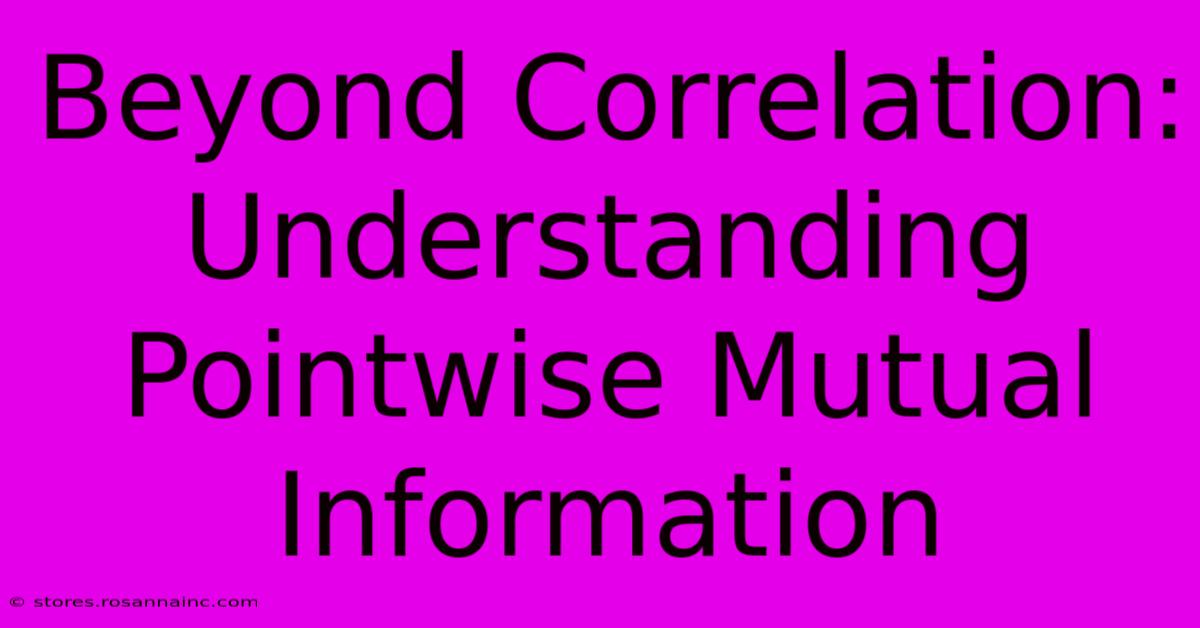Beyond Correlation: Understanding Pointwise Mutual Information

Table of Contents
Beyond Correlation: Understanding Pointwise Mutual Information (PMI)
Correlation is a widely used measure to assess the relationship between two variables. However, correlation alone often falls short in capturing the nuances of probabilistic dependencies. This is where Pointwise Mutual Information (PMI) steps in, offering a more precise and insightful approach to understanding the relationship between events or variables. This article dives deep into PMI, explaining its concept, calculation, applications, and limitations.
What is Pointwise Mutual Information?
Pointwise Mutual Information (PMI) quantifies the amount of information obtained about one random variable through observing another. Unlike correlation, which measures linear relationships, PMI assesses the association between events regardless of their linearity. It measures how much knowing one event changes the probability of another event occurring. A higher PMI value indicates a stronger association. Crucially, PMI is pointwise, meaning it calculates the mutual information for specific pairs of events, not the overall relationship between variables.
Understanding the Basics
Imagine you have two events, A and B. Their probabilities are P(A) and P(B) respectively. The joint probability of both events occurring together is P(A,B). PMI is defined as:
PMI(A, B) = log₂[P(A, B) / (P(A) * P(B))]
Let's break down this formula:
- P(A, B): The probability of both A and B occurring simultaneously.
- P(A) * P(B): The probability of A and B occurring independently. This represents the expected probability if A and B were unrelated.
- P(A, B) / (P(A) * P(B)): This ratio shows how much more (or less) likely A and B are to occur together than if they were independent. A ratio greater than 1 indicates a positive association, while a ratio less than 1 indicates a negative association.
- log₂(): The logarithm base 2 converts the ratio into bits of information. A higher PMI value signifies a stronger association, representing a larger reduction in uncertainty about one event given the occurrence of the other.
Interpreting PMI Values
- PMI(A, B) > 0: A and B are more likely to occur together than expected by chance. This indicates a positive association.
- PMI(A, B) = 0: The occurrence of A provides no information about the occurrence of B (and vice-versa). They are statistically independent.
- PMI(A, B) < 0: A and B are less likely to occur together than expected by chance. This indicates a negative association.
Applications of Pointwise Mutual Information
PMI finds applications in diverse fields, including:
-
Natural Language Processing (NLP): Identifying word collocations and relationships in text corpora. For example, PMI can help determine which words frequently appear together, revealing important semantic connections. This is crucial for tasks like text summarization, machine translation, and sentiment analysis.
-
Information Retrieval: Improving search engine relevance by identifying strong associations between search queries and documents.
-
Bioinformatics: Analyzing gene co-expression and identifying functional relationships between genes.
-
Image Processing: Analyzing pixel relationships and identifying patterns in images.
Limitations of Pointwise Mutual Information
While powerful, PMI also has limitations:
-
Sensitivity to Low Probabilities: PMI is highly sensitive to events with low probabilities. Even a small change in probabilities can lead to large changes in PMI. This can lead to inflated PMI values for infrequent events.
-
Data Sparsity: In datasets with limited data points, the estimates of probabilities can be unreliable, impacting the accuracy of PMI calculations. Smoothing techniques can mitigate this issue.
-
Lack of Normalization: PMI values are not directly comparable across different datasets or contexts.
Addressing the Limitations: Normalized Pointwise Mutual Information (NPMI)
To address some of PMI's limitations, especially the sensitivity to low probabilities, Normalized Pointwise Mutual Information (NPMI) is often preferred:
NPMI(A, B) = PMI(A, B) / -log₂[P(A, B)]
NPMI normalizes PMI values between -1 and 1, making comparisons more meaningful across different contexts. A value of 1 represents perfect positive association, -1 represents perfect negative association, and 0 indicates independence.
Conclusion
Pointwise Mutual Information provides a powerful tool for analyzing the relationships between events. Understanding its strengths and weaknesses, and considering the use of normalized PMI, is crucial for its effective application in various domains. Its ability to capture non-linear associations surpasses the limitations of simple correlation measures, making it a valuable asset in data analysis and interpretation. While challenges exist, particularly concerning low probabilities and data sparsity, careful consideration of these limitations and the application of techniques like NPMI allows for more robust and insightful analysis.

Thank you for visiting our website wich cover about Beyond Correlation: Understanding Pointwise Mutual Information. We hope the information provided has been useful to you. Feel free to contact us if you have any questions or need further assistance. See you next time and dont miss to bookmark.
Featured Posts
-
The Hidden Story Behind Adele Bloch Bauer Is Gaze
Feb 10, 2025
-
Trump At Super Bowl Whos He With
Feb 10, 2025
-
Ecosse Vs Irlande Le Defi
Feb 10, 2025
-
Unlocking The Secrets Of Area Code 604
Feb 10, 2025
-
From President To Millions Bill Clintons Wealth Revealed
Feb 10, 2025
